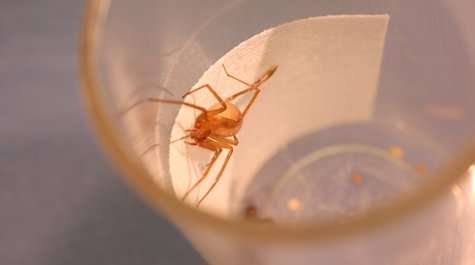Unraveling another secret of spider silk—it's a cable

Scientists are spinning out the secrets of one of nature's most intriguing and potentially valuable materials—spider silk.
A strand of spider silk is five times stronger than a steel cable of the same weight, said Hannes Schniepp of the Department of Applied Science at William & Mary. His lab has been unraveling the secrets behind the strength of the brown recluse spider.
Their latest discovery is a surprise: The brown recluse does not spin a single strand of protein fiber.
"We were expecting to find that the fiber was a single mass," Schniepp explained. "But what we found was that the silk was actually a kind of tiny cable."
The discovery comes on top of a 2017 report from the same lab revealing that another factor in the strength of brown recluse silk comes from loops spun into the structure. The work is funded by the National Science Foundation. Spider silk is an important topic as its strength and toughness makes synthetic spider silk something of a "holy grail" of materials science and engineering.
"Understanding the reasons why spider silk has increased mechanical toughness compared to insect silks has been a primary motivator for a number of studies, as well as the desire to produce large quantities of spider silk synthetically in the laboratory. From this perspective, the results being reported provide an interesting clue to the 'tricks of the trade' that nature has in producing amazing materials," says NSF program director Mohan Srinivasarao, who helped fund the research.
"Understanding the properties of brown recluse silk at the molecular level not only provides insights into one of nature's toughest materials, it may also provide a pathway for the design of other synthetic materials," he added.
Schniepp and Qijue Wang, a graduate student in applied science, described their findings in a paper, "Strength of Recluse Spider's Silk Originates from Nanofibrils," in ACS Macro Letters, a highly-cited journal of the American Chemical Society. They used an extremely sensitive technique known as atomic force microscopy to examine the structure of the spider silk at the molecular level.

"It turns out that the fiber is made of a number of nanostrands," Schniepp said. "Each nanostrand is a thin thread made of protein, less than a millionth of an inch in diameter."
The paper reports that a typical recluse-silk filament is made up of around 2,500 nanostrands. Schniepp and Wang developed a detailed structural model of the silk, revealing also other interesting characteristics of the recluse's cable structure.
Scientists have long known that recluse silk is flat, rather than round, in cross section. Curiously, Schniepp and Wang report that the nanostrands, or nanofibrils, that make up the cable are not braided or twisted like rope, but rather are arranged in parallel.
It's difficult to describe just how thin a recluse ribbon is. Even that old standby of thinness, the human hair, proves to be unsatisfactory.
"How do you compare thickness of a round hair to a flat ribbon?" Schniepp asked. "That's a bit of a tricky one if you want to be accurate."
He added that an accurate comparison takes into account not only the thickness of the recluse ribbon, which is a thousand times less than the thickness of a hair, but also the fact that the cross-section of the hair is ten times that of the silk strand. Consequently, Schniepp said, the silk cross-section is 1/10,000th that of a human hair.
Schniepp and Wang also found that the individual nanostrands are easily separated from one another, indicating that the bonds between the nanofibrils are relatively weak. But they also found that one key to the strength of the silk structure lies in the length of each individual nanostrand.
Scientists have proposed a number of models to explain spider silk's organizational makeup and what that structure contributes to the desirable and important properties of toughness and strength. Schniepp says that the structure proposed in the paper is the simplest and most elegant of the major models.
"We believe that the secret of brown recluse spider silk essentially stems from the individual nanofibril," he said.
More information: Qijue Wang et al. Strength of Recluse Spider's Silk Originates from Nanofibrils, ACS Macro Letters (2018). DOI: 10.1021/acsmacrolett.8b00678
Journal information: ACS Macro Letters
Provided by The College of William & Mary





















